Abstract
Influence of altered blood oxygen affinity on maximal performance ability was evaluated in trained rats exercising to exhaustion in a graded treadmill test. Modification of blood oxygen affinity was achieved both by 2,3-diphosphoglycerate depletion, accomplished by exposure of animals to CO2 and by exchange transfusion with blood exposed to bisulfite or stored in acid citrate dextrose, and by carbamylation of hemoglobin, produced by exchange transfusion of blood incubated with potassium cyanate. A decrease in oxygen tension at half-saturation of hemoglobin (P50) from 36 to 23 mm Hg produced a decrease in resting central venous oxygen pressure of about 12 mm Hg. During exercise it caused an average decrease in work performance of about 10%, which was equivalent to that performance decrement caused by a decrease in hemoglobin concentration of approximately 10%. When superimposed on anemia, this change in blood oxygen affinity again caused a similar decrease in performance over and above that due to anemia alone. A marked rightward shift of the in vivo oxygen dissociation curve during severe exercise may have compensated for the reduced in vitro P50.
Full text
PDF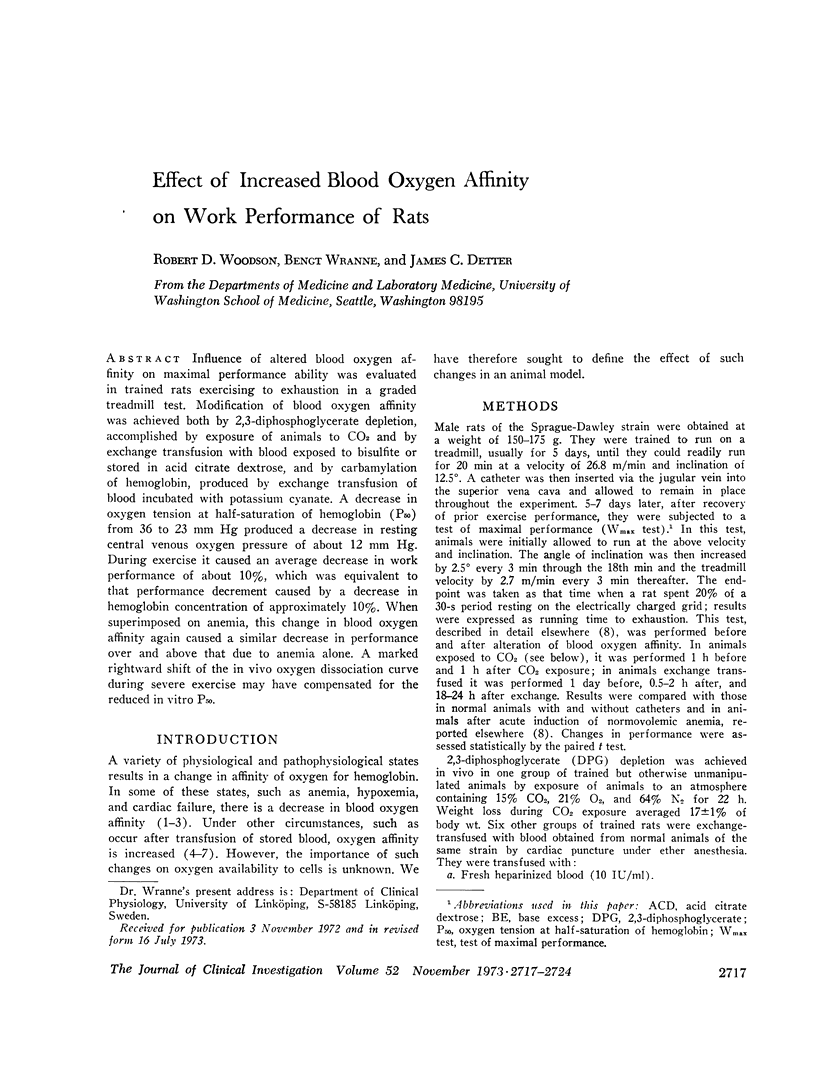
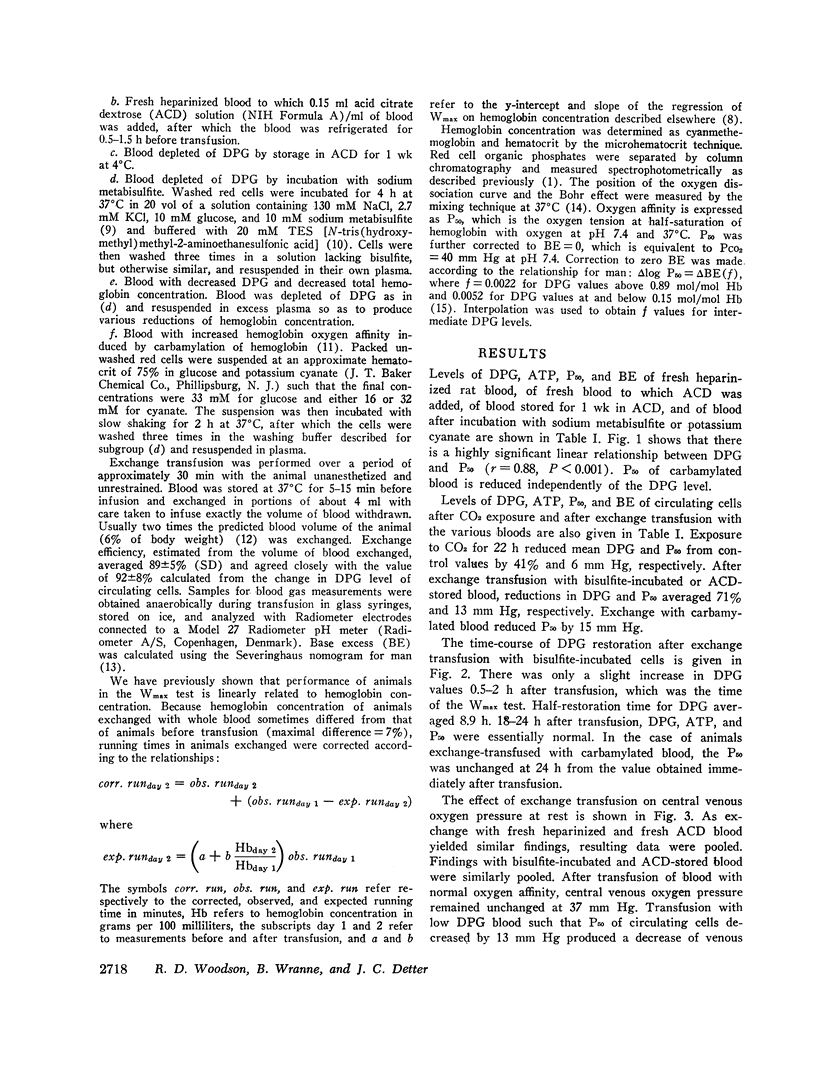
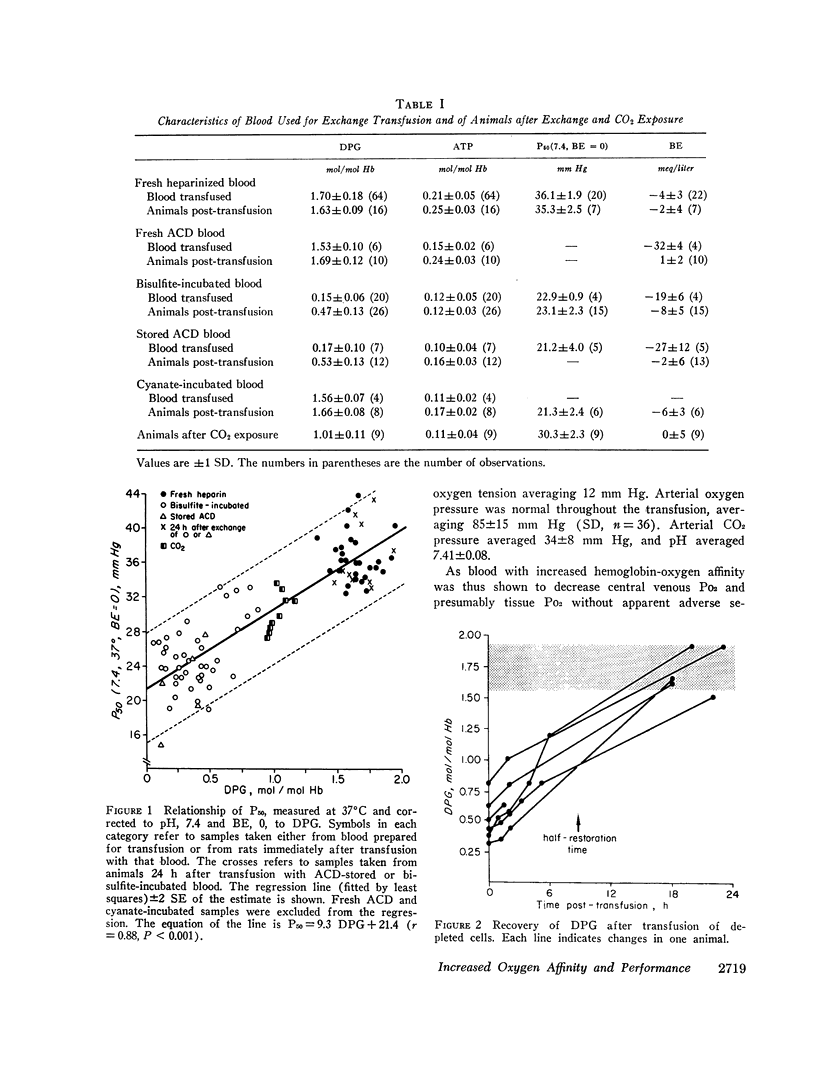
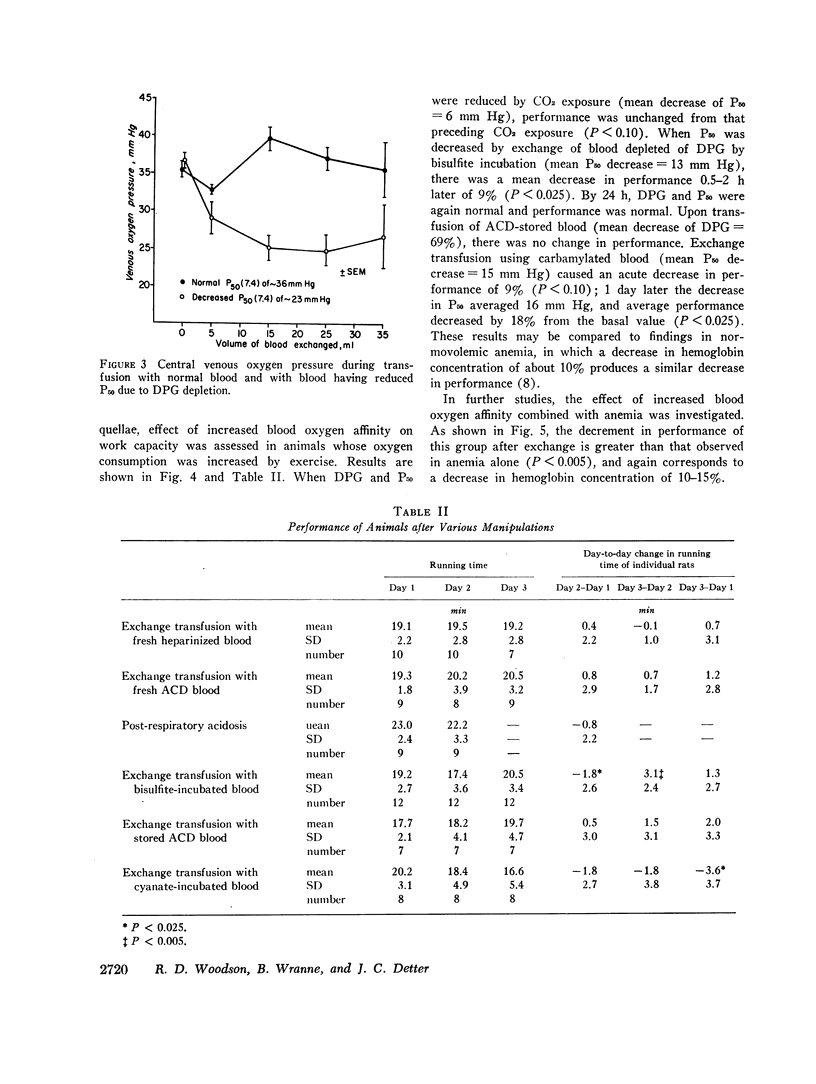
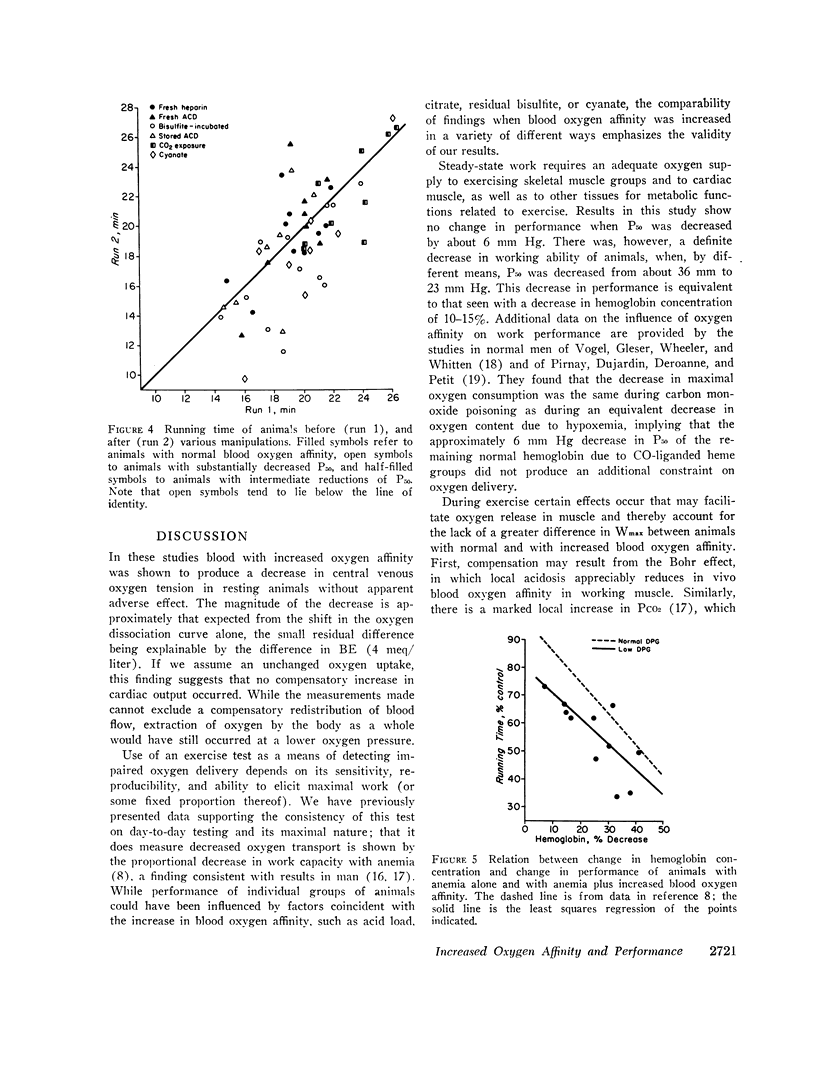

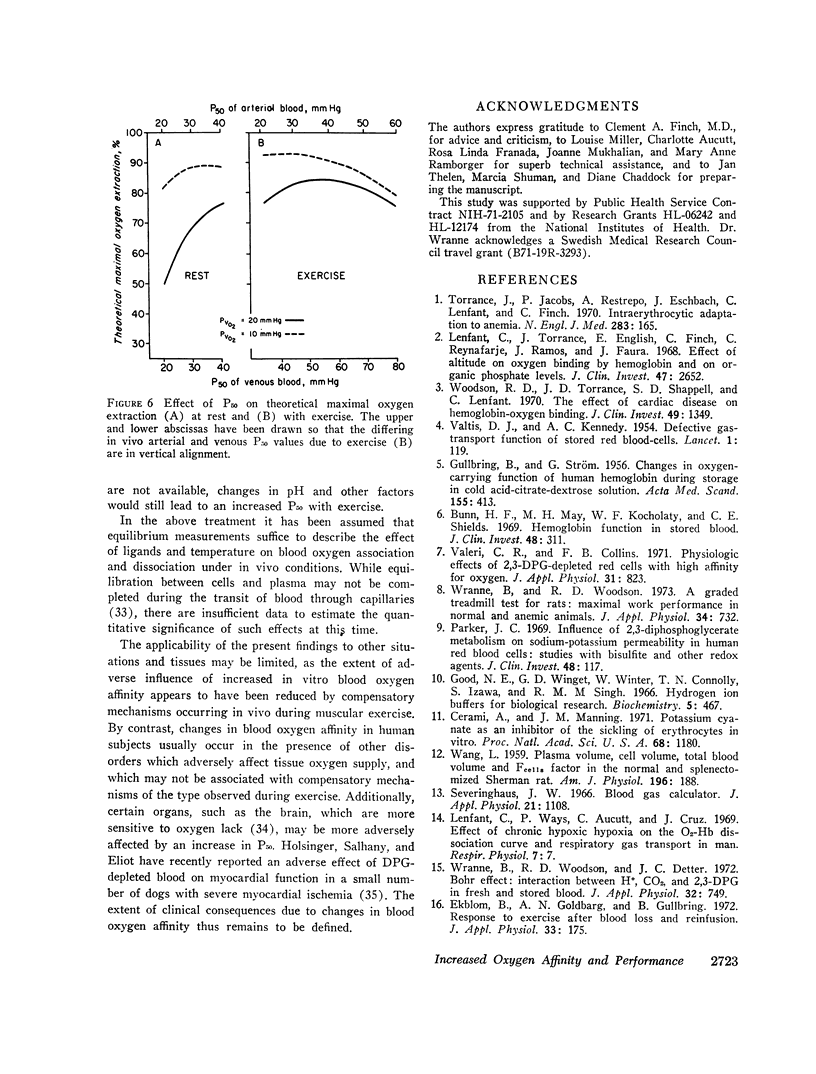
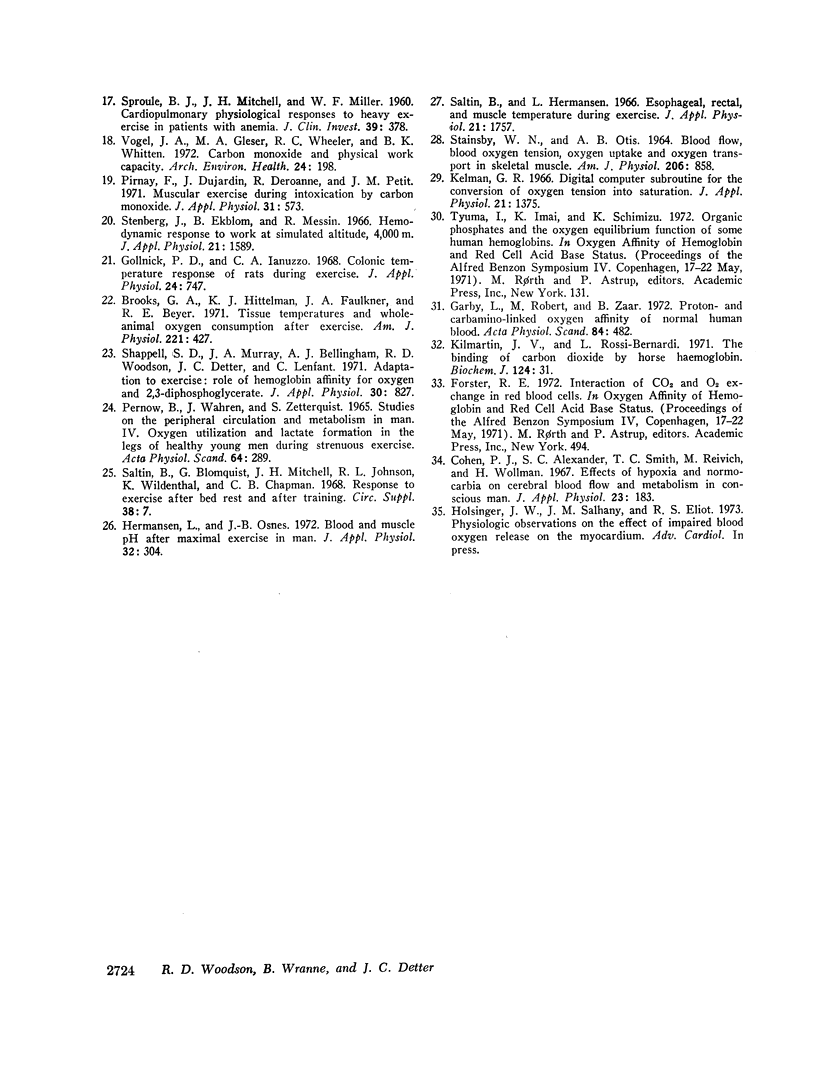
Images in this article
Selected References
These references are in PubMed. This may not be the complete list of references from this article.
- Brooks G. A., Hittelman K. J., Faulkner J. A., Beyer R. E. Tissue temperatures and whole-animal oxygen consumption after exercise. Am J Physiol. 1971 Aug;221(2):427–431. doi: 10.1152/ajplegacy.1971.221.2.427. [DOI] [PubMed] [Google Scholar]
- Bunn H. F., May M. H., Kocholaty W. F., Shields C. E. Hemoglobin function in stored blood. J Clin Invest. 1969 Feb;48(2):311–321. doi: 10.1172/JCI105987. [DOI] [PMC free article] [PubMed] [Google Scholar]
- Cerami A., Manning J. M. Potassium cyanate as an inhibitor of the sickling of erythrocytes in vitro. Proc Natl Acad Sci U S A. 1971 Jun;68(6):1180–1183. doi: 10.1073/pnas.68.6.1180. [DOI] [PMC free article] [PubMed] [Google Scholar]
- Cohen P. J., Alexander S. C., Smith T. C., Reivich M., Wollman H. Effects of hypoxia and normocarbia on cerebral blood flow and metabolism in conscious man. J Appl Physiol. 1967 Aug;23(2):183–189. doi: 10.1152/jappl.1967.23.2.183. [DOI] [PubMed] [Google Scholar]
- Ekblom B., Goldbarg A. N., Gullbring B. Response to exercise after blood loss and reinfusion. J Appl Physiol. 1972 Aug;33(2):175–180. doi: 10.1152/jappl.1972.33.2.175. [DOI] [PubMed] [Google Scholar]
- GULLBRING B., STROM G. Changes in oxygen-carrying function of human hemoglobin during storage in cold acid-citrate-dextrose solution. Acta Med Scand. 1956 Nov 5;155(6):413–430. doi: 10.1111/j.0954-6820.1956.tb14390.x. [DOI] [PubMed] [Google Scholar]
- Garby L., Robert M., Zaar B. Proton- and carbamino-linked oxygen affinity of normal human blood. Acta Physiol Scand. 1972 Apr;84(4):482–492. doi: 10.1111/j.1748-1716.1972.tb05198.x. [DOI] [PubMed] [Google Scholar]
- Gollnick P. D., Ianuzzo C. D. Colonic temperature response of rats during exercise. J Appl Physiol. 1968 Jun;24(6):747–750. doi: 10.1152/jappl.1968.24.6.747. [DOI] [PubMed] [Google Scholar]
- Good N. E., Winget G. D., Winter W., Connolly T. N., Izawa S., Singh R. M. Hydrogen ion buffers for biological research. Biochemistry. 1966 Feb;5(2):467–477. doi: 10.1021/bi00866a011. [DOI] [PubMed] [Google Scholar]
- Hermansen L., Osnes J. B. Blood and muscle pH after maximal exercise in man. J Appl Physiol. 1972 Mar;32(3):304–308. doi: 10.1152/jappl.1972.32.3.304. [DOI] [PubMed] [Google Scholar]
- Kelman G. R. Digital computer subroutine for the conversion of oxygen tension into saturation. J Appl Physiol. 1966 Jul;21(4):1375–1376. doi: 10.1152/jappl.1966.21.4.1375. [DOI] [PubMed] [Google Scholar]
- Kilmartin J. V., Rossi-Bernardi L. The binding of carbon dioxide by horse haemoglobin. Biochem J. 1971 Aug;124(1):31–45. doi: 10.1042/bj1240031. [DOI] [PMC free article] [PubMed] [Google Scholar]
- Lenfant C., Torrance J., English E., Finch C. A., Reynafarje C., Ramos J., Faura J. Effect of altitude on oxygen binding by hemoglobin and on organic phosphate levels. J Clin Invest. 1968 Dec;47(12):2652–2656. doi: 10.1172/JCI105948. [DOI] [PMC free article] [PubMed] [Google Scholar]
- Lenfant C., Ways P., Aucutt C., Cruz J. Effect of chronic hypoxic hypoxia on the O2-Hb dissociation curve and respiratory gas transport in man. Respir Physiol. 1969 Jun;7(1):7–29. doi: 10.1016/0034-5687(69)90066-8. [DOI] [PubMed] [Google Scholar]
- Parker J. C. Influence of 2,3-diphosphoglycerate metabolism on sodium-potassium permeability in human red blood cells: studies with bisulfite and other redox agents. J Clin Invest. 1969 Jan;48(1):117–125. doi: 10.1172/JCI105960. [DOI] [PMC free article] [PubMed] [Google Scholar]
- Pernow B., Wahren J., Zetterquist S. Studies on the peripheral circulation and metabolism in man. IV. Oxygen utilization and lactate formation in the legs of healthy young men during strenuous exercise. Acta Physiol Scand. 1965 Aug;64(4):289–298. doi: 10.1111/j.1748-1716.1965.tb04182.x. [DOI] [PubMed] [Google Scholar]
- Pirnay F., Dujardin J., Deroanne R., Petit J. M. Muscular exercise during intoxication by carbon monoxide. J Appl Physiol. 1971 Oct;31(4):573–575. doi: 10.1152/jappl.1971.31.4.573. [DOI] [PubMed] [Google Scholar]
- SPROULE B. J., MITCHELL J. H., MILLER W. F. Cardiopulmonary physiological responses to heavy exercise in patients with anemia. J Clin Invest. 1960 Feb;39:378–388. doi: 10.1172/JCI104048. [DOI] [PMC free article] [PubMed] [Google Scholar]
- STAINSBY W. N., OTIS A. B. BLOOD FLOW, BLOOD OXYGEN TENSION, OXYGEN UPTAKE, AND OXYGEN TRANSPORT IN SKELETAL MUSCLE. Am J Physiol. 1964 Apr;206:858–866. doi: 10.1152/ajplegacy.1964.206.4.858. [DOI] [PubMed] [Google Scholar]
- Saltin B., Hermansen L. Esophageal, rectal, and muscle temperature during exercise. J Appl Physiol. 1966 Nov;21(6):1757–1762. doi: 10.1152/jappl.1966.21.6.1757. [DOI] [PubMed] [Google Scholar]
- Severinghaus J. W. Blood gas calculator. J Appl Physiol. 1966 May;21(3):1108–1116. doi: 10.1152/jappl.1966.21.3.1108. [DOI] [PubMed] [Google Scholar]
- Shappell S. D., Murray J. A., Bellingham A. J., Woodson R. D., Detter J. C., Lenfant C. Adaptation to exercise: role of hemoglobin affinity for oxygen and 2,3-diphosphoglycerate. J Appl Physiol. 1971 Jun;30(6):827–832. doi: 10.1152/jappl.1971.30.6.827. [DOI] [PubMed] [Google Scholar]
- Stenberg J., Ekblom B., Messin R. Hemodynamic response to work at simulated altitude, 4,000 m. J Appl Physiol. 1966 Sep;21(5):1589–1594. doi: 10.1152/jappl.1966.21.5.1589. [DOI] [PubMed] [Google Scholar]
- Torrance J., Jacobs P., Restrepo A., Eschbach J., Lenfant C., Finch C. A. Intraerythrocytic adaptation to anemia. N Engl J Med. 1970 Jul 23;283(4):165–169. doi: 10.1056/NEJM197007232830402. [DOI] [PubMed] [Google Scholar]
- VALTIS D. J. Defective gas-transport function of stored red blood-cells. Lancet. 1954 Jan 16;266(6803):119–124. doi: 10.1016/s0140-6736(54)90978-2. [DOI] [PubMed] [Google Scholar]
- Valeri C. R., Collins F. B. Physiologic effects of 2,3-DPG-depleted red cells with high affinity for oxygen. J Appl Physiol. 1971 Dec;31(6):823–827. doi: 10.1152/jappl.1971.31.6.823. [DOI] [PubMed] [Google Scholar]
- Vogel J. A., Gleser M. A., Wheeler R. C., Whitten B. K. Carbon monoxide and physical work capacity. Arch Environ Health. 1972 Mar;24(3):198–203. doi: 10.1080/00039896.1972.10666069. [DOI] [PubMed] [Google Scholar]
- WANG L. Plasma volume, cell volume, total blood volume and F cells factor in the normal and splenectomized Sherman rat. Am J Physiol. 1959 Jan;196(1):188–192. doi: 10.1152/ajplegacy.1958.196.1.188. [DOI] [PubMed] [Google Scholar]
- Woodson R. D., Torrance J. D., Shappell S. D., Lenfant C. The effect of cardiac disease on hemoglobin-oxygen binding. J Clin Invest. 1970 Jul;49(7):1349–1356. doi: 10.1172/JCI106351. [DOI] [PMC free article] [PubMed] [Google Scholar]
- Wranne B., Woodson R. D. A graded treadmill test for rats: maximal work performance in normal and anemic animals. J Appl Physiol. 1973 May;34(5):732–735. doi: 10.1152/jappl.1973.34.5.732. [DOI] [PubMed] [Google Scholar]
- Wranne B., Woodson R. D., Detter J. C. Bohr effect: interaction between H + , CO 2 , and 2,3-DPG in fresh and stored blood. J Appl Physiol. 1972 Jun;32(6):749–754. doi: 10.1152/jappl.1972.32.6.749. [DOI] [PubMed] [Google Scholar]



